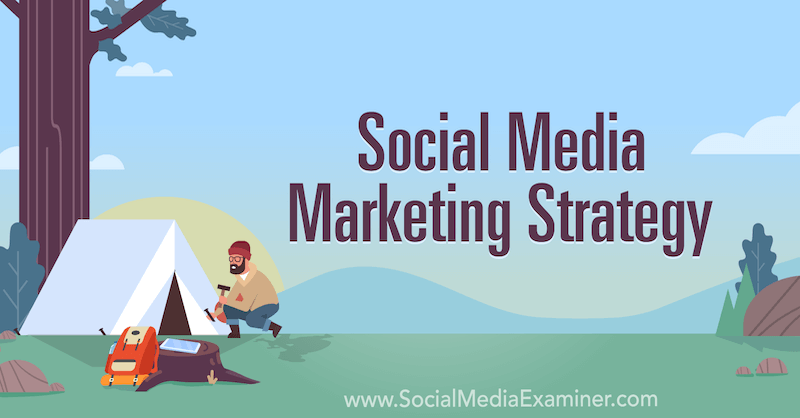Looking for a better social media marketing strategy? Need to build a social strategy that works?
In this article, you'll learn a proven method for creating a social strategy that will guide you closer to your marketing goals.

Why Social Media Strategy Is More Important Than Ever
For the past year and a half during the pandemic, people have turned to social in droves for both entertainment and communication. But now that the country is starting to open back up, we're in a bit of a transition period.
People are doing more activities outside and spending more time with others in person. They're beginning to go back to restaurants and small local events, and eventually larger sporting events, concerts, and experiences. And as a result, there will be a change in behavior on social. That's why having a social media marketing strategy is so important.
Just showing up and being active on social media gives you no inherent results. If you don't have a strategy—you don't know who your audience is and what your key messages are—it won't work. The algorithms are too smart and the competition is too fierce.
The one thing that's true about social that's not true of every other kind of marketing is that you're competing against the whole world. In traditional marketing, you're competing against companies that sell the same things you do. On social, you're competing against everything else that's going on in the world and the news feed is cramped.
Chances are, what people react to on social isn't going to be content from a business. It's going to be content from people they know. That makes it all the harder for businesses and strategy becomes imperative. You have to know what you're doing, because otherwise, social doesn't work and it can become very expensive if you're trying to pay for reach and engagement every time.
The Role of Content in Social Media Strategy
From a business perspective, you can think of social as two sides of the same coin. You have proactive social, where you're posting something to create awareness or change behavior in some way. And then you have reactive social, which in many cases is social care or social customer service. Both are important, especially for large companies that customers reach out to on social constantly.
On the content side, social is either where the content exists or where you amplify the content—but usually both.
When we talk about content in the context of social strategy, think of anything you create or curate that you want to put in front of a customer or a prospective customer to change their thinking or behavior, such as a podcast or a video on YouTube. If you're promoting an eBook on social that people have to go to a web page to download, that's social as amplification.
Think about where the content lives. Where is its home base? If you have a video series where the videos themselves are native to LinkedIn, that's social content, even if people can access those videos in a collection on your website or YouTube. If you have a blog and promote each individual blog post on social, that's social as an amplification lever.
Before we talk about the elements of a good social strategy, it's important to understand that social media isn't free. You're going to have to spend time on it and maybe invest in buying software and hiring designers or video editors. There's also a huge opportunity cost—you could be doing something else with the time you're spending on social.
Here's how to create a social strategy that will support your marketing goals.
#1: Determine Why You're Using Social Media
Even though social is pervasive in our lives, there's no rule that says you have to use it. So the first question to ask in any social media strategy is, why do this at all? What's the business value? Focus on what you're trying to achieve as a company and how social media will support that.
Get World-Class Marketing Training — All Year Long!
Are you facing doubt, uncertainty, or overwhelm? The Social Media Marketing Society can help.
Each month, you’ll receive training from trusted marketing experts, covering everything from AI to organic social marketing. When you join, you’ll also get immediate access to:
- A library of 100+ marketing trainings
- A community of like-minded marketers
- Monthly online community meetups
- Relevant news and trends updates
Let's take higher education as an example. Different parts of a university have different goals for social so there can't be a singular strategy. There have to be multiple social strategies that work together. Here are some examples of how a university might use social:
- Inform potential donors about the work the university is doing and how they can help support that.
- Educate and inspire potential students—high-school students and sometimes international or non-traditional students.
- Keep current students informed and make sure they're having a great experience.
- Offer customer service.
- Recruit professors and support staff.
All of these independent initiatives roll up into one university-wide social strategy.
This same approach works for any organization or business. You want to be out there and present in front of your ideal audience—whether that ideal audience is a customer or prospective customer—and potentially make a sale.
Once you know your why, you can start devising a good social strategy.
#2: Identify Where Your Audience Is by Social Platform
The first element of a social strategy is your audience. Who are you trying to reach? You need to put together a target audience for each social channel because your audience on TikTok is likely to be different from your audience on Facebook.
Historically, we've thought of social media horizontally—like it's one thing—but it's not. It's a series of channels, each having a different purpose, audience, and success path.
Going back to the university example, if you're trying to reach donors, who are typically older, they're not on Snapchat. And if you're trying to reach current or prospective students, they're not on LinkedIn yet—but they are on TikTok.

Keep in mind that you don't need to be everywhere with your social strategy, especially if you're a smaller business. Typically, when you try to be everywhere, you're going to be mediocre everywhere. So pick the channels where your most important audiences are because not every audience can be of equal importance.
#3: Create Content Themes Around What's Unique About Your Product or Business
Once you've identified your audience by platform, think about what content themes are going to resonate with the unique audiences on each channel you're on.
Inside those themes, you'll plan “shows”—which are the social media executions you're going to post and the key elements of that content. Jay recommends creating shows because he believes that consistent episodic social generally works better than random social because your audience remembers that they can tune in. They know you for it and recognize it.
Start by creating a group of themes centered around what makes your business unique from your competitors.
For example, one of Jay's clients is Purdue University. Like lots of universities, they have a million stories to tell. It's a big school and legendary research institution so there are lots of things they could point to as their why. They narrowed it down to eight key themes—including affordability, innovation, and diversity—that differentiate Purdue from other higher-education institutions.
Once you've identified your themes, decide which themes will resonate best on which social channel.
Purdue probably wouldn't want to use the affordability theme on LinkedIn because that's where they're trying to reach donors. That audience doesn't care about affordability because they've already graduated. But affordability is going to matter to parents of prospective and current students, so where are they? You want to assign your themes to the channels based on where those audiences are.

Discover Proven Marketing Strategies and Tips
Want to go even deeper with your marketing? Check out the Social Media Marketing Podcast! Publishing weekly since 2012, the Social Media Marketing Podcast helps you navigate the constantly changing marketing jungle, with expert interviews from marketing pros.
But don’t let the name fool you. This show is about a lot more than just social media marketing. With over 600 episodes and millions of downloads each year, this show has been a trusted source for marketers for well over a decade.

Innovation is a message that will resonate with prospective Purdue faculty, staff, and donors so they could lean into that theme on LinkedIn and Twitter. They could create a weekly LinkedIn Live series where they interview a professor or researcher who's doing groundbreaking work.

This same process can work for any business. The only difference is you may not have the people or budget to be on every social media channel. So you might decide to focus on Instagram, Twitter, and Facebook because you only have the time, money, energy, and people to support those three.
With fewer channels, you'll likely want to do fewer, less-involved shows. So rather than an interview series, you might do a carousel with simple images that talk about interesting things you're doing in your plumbing business.
Once you lay this groundwork, you'll have a playbook you can follow for your content. You'll know you want to create [content] around [theme] for the audience on [channel] to achieve [success metric] and move the company forward in [goal].
#4: Decide How to Amplify Your Social Content
Once you've outlined your content themes, you need to give some thought to amplification. If you're going to do a weekly LinkedIn Live show, other than just doing the show, how will people find out about it? How are you going to get the word out? Do you need to put some paid against it?
If you haven't built up all of your social channels and don't have the budget, you can always amplify through organic. If your company has a YouTube show, you could amplify it through your personal Twitter account and it won't cost you anything. Amplification can also come from your employees, customers, or your email newsletter.
#5: Measure Your Success
The final step in your strategy is to measure performance. It's important to look at all of the components of success. One aspect of that is measuring how many people are seeing, liking, and sharing your posts. And if traffic generation from social and products sold are some of your goals, look at that data, too.
It's important to get some clarity around the metrics. Wherever possible, report the metrics holistically; for example, what's your total audience across all of your channels—not just Instagram? While you want to outline your strategy by channel, you do the reporting together.
Jay's business uses Rival IQ for a lot of their data. They also use Meltwater. But sometimes there's no substitute for just logging into the tool and pulling your numbers. To create the actual reports, Jay uses a system his company set up in Airtable.
When analyzing data, a mistake that a lot of marketers make is that they don't look at the data in terms of goals so it's difficult for them to know what's working and what isn't. You need some standard to measure against.
Start with setting a goal for yourself. For instance, you could look backward 90 days to determine a baseline and then set a goal that you're going to beat that by 20%.
You also want to compare yourself to the companies you're competing against. One of the reasons Jay uses Rival IQ is that it's good at competitive analysis. For each client, he sets up a report that pulls in all of the client's social media data (except LinkedIn because of the way their API works). He can tell in two clicks how his clients are doing on Instagram versus their competitors at the per-post level, and even by stories vs. the news feed.
A lot of marketers gather data but don't do anything with it. Let's take retention on a YouTube video as an example. If you have a 14-minute video and see that everybody is dropping off after 3.5 minutes, you need to change the way you do the video. Try something new and see if it performs better.
Measurement can help guide your next steps. Are the shows you launched the right shows? Do you need to try to amplify them differently? Do you need to create different shows? Do you need to be on a different social channel? Maybe you didn't launch on Snapchat because you didn't have the resources but now you do.
It's important to have a continuous testing and optimization mindset because things change quickly on social—the algorithms are tweaked, new social channels pop up, new features are released, and so on. You need to treat your social media strategy as a living document and revisit it constantly.
In addition to what you can measure on social, there's also the social listening and insights piece that's hard to put a value on. You can learn a lot about your audience and product or service and what your customers care about just by engaging with them and seeing how they interact with you on social. This benefit gets overlooked all the time because it's hard to measure, but what you learn about the people you're trying to sell to on social is incalculable.
Listen to the show to hear how Jay uses this framework to guide the social media strategy at Convince & Convert.
Jay Baer is a marketing strategist and founder of Convince & Convert, a digital marketing and customer experience consultancy. He's also co-host of the Social Pros Podcast and co-author of Talk Triggers and many other books. Connect with Jay @convince and @jaybaer on Twitter.
Other Notes From This Episode
- Read more about Jay's Seven A's measurement scheme.
- Learn more about Rival IQ, Meltwater, and Airtable.
- Connect with Michael Stelzner at @Stelzner on Instagram.
- Watch exclusive content and original videos from Social Media Examiner on YouTube.
- Tune into our weekly Social Media Marketing Talk Show. Watch live on Fridays at 12 PM Pacific on YouTube. Listen to the replay on Apple Podcasts or Google Podcasts.
Listen to the Podcast Now
This article is sourced from the Social Media Marketing Podcast, a top marketing podcast. Listen or subscribe below.
Where to subscribe: Apple Podcasts | Spotify | YouTube Music | YouTube | Amazon Music | RSS
❇️ Help Us Spread the Word! Please let your Twitter followers know about this podcast. Simply click here now to post a tweet.
✋🏽 If you enjoyed this episode of the Social Media Marketing podcast, please head over to Apple Podcasts, leave a rating, write a review, and subscribe.
Attention Agency Owners, Brand Marketers, and Consultants

Introducing the Marketing Agency Show–our newest podcast designed to explore the struggles of agency marketers.
Join show host and agency owner, Brooke Sellas, as she interviews agency marketers and digs deep into their biggest challenges. Explore topics like navigating rough economic times, leveraging AI, service diversification, client acquisition, and much more.
Just pull up your favorite podcast app, search for Marketing Agency Show and start listening. Or click the button below for more information.

